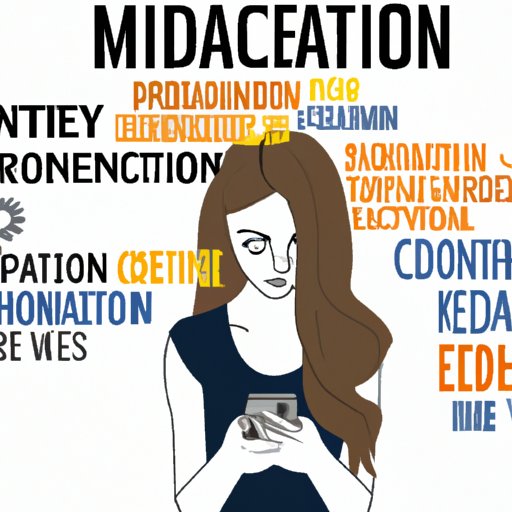Introduction
Technology has revolutionized our lives in countless ways. From communication to commerce, entertainment to education, technology has become a part of almost every aspect of modern life. But while technology can be incredibly beneficial, it is also possible to become addicted to it, leading to physical, emotional and behavioral problems. In this article, we explore what technology addiction is, the neuroscience behind it, the potential risks and benefits of technology use, and how to manage technology addiction.
Definition of Technology Addiction
Technology addiction, also referred to as digital addiction or internet addiction, is defined as an excessive reliance on technology that leads to impairment in daily functioning. According to the American Psychiatric Association (APA), technology addiction is not yet included in the Diagnostic and Statistical Manual of Mental Disorders (DSM-5), but it is being considered for inclusion in the future.
Overview of the Problem
Technology addiction is becoming increasingly common, particularly among young people. A recent survey by Common Sense Media found that teens spend an average of nine hours per day using digital media, with many spending even more time online. This excessive use of technology can lead to a range of physical, emotional and behavioral problems.
Exploring the Neuroscience Behind Technology Addiction
Understanding the neuroscience behind technology addiction can help us better understand why it is so difficult to break away from it. Research suggests that technology use activates the same reward pathways in the brain as other addictive substances and activities, such as drugs and gambling. When someone uses technology, their brain releases dopamine, a neurotransmitter associated with pleasure and reward. Over time, the brain begins to expect and crave this reward, leading to an addictive cycle.
What are the Causes and Triggers of Technology Addiction?
There are a number of factors that can contribute to technology addiction, including genetics, environmental influences, and individual psychological traits. For example, research has found that people who have higher levels of impulsivity, anxiety or depression may be more likely to become addicted to technology. Other risk factors include easy access to technology, unstructured home environments, and permissive parenting styles.
Examining the Impact of Technology on Mental Health and Well-Being
Excessive technology use can have serious consequences for mental health and well-being. Studies have shown that technology use can have a negative impact on stress, anxiety and depression levels. For example, one study found that people who used social media more than two hours per day were twice as likely to report feeling depressed compared to those who used it less than two hours per day.
In addition, there is growing evidence that technology use can lead to cognitive decline. One study found that excessive technology use was associated with decreased attention span, difficulty concentrating, and reduced memory.

Investigating Common Symptoms of Technology Addiction
Technology addiction can manifest itself in a variety of physical, emotional and behavioral symptoms. Common physical symptoms include headaches, eyestrain, fatigue, and weight gain. Emotional symptoms include feelings of guilt, shame, irritability, and sadness. Behavioral symptoms include neglecting responsibilities, isolation, neglecting personal hygiene, and compulsive use of technology.
Highlighting the Role of Social Media in Digital Addiction
Social media platforms play a major role in driving technology addiction. Studies have found that these platforms are designed to be highly addictive, incorporating features such as autoplay, notifications, and “likes” that encourage users to stay engaged for longer periods of time. Additionally, research has shown that spending too much time on social media can lead to increased feelings of loneliness, envy, and insecurity.

Examining the Role of Parenting Styles in Technology Addiction
Parenting styles can also play a role in shaping technology addiction patterns. Studies have found that children who grow up in unstructured home environments, where there is little structure or guidance, are more likely to develop problematic technology use. Similarly, children who are raised in permissive households, where parents are lax in setting boundaries and monitoring behavior, are more likely to struggle with technology addiction.
Analyzing the Pros and Cons of Technology Use
It is important to recognize that there are both benefits and potential dangers of technology use. On the positive side, technology can be incredibly useful for staying connected with family and friends, accessing information quickly and easily, and increasing productivity. However, it is important to be aware of the potential risks of technology use, such as cyberbullying, privacy issues, and addiction.

Understanding How to Manage Technology Addiction
If you or someone you know is struggling with technology addiction, it is important to take steps to address the problem. Establishing healthy boundaries around technology use is key, such as limiting screen time and avoiding technology late at night. Additionally, seeking professional help can be beneficial for managing technology addiction. Counseling, therapy, and support groups can all be helpful for addressing the underlying causes of technology addiction.
Conclusion
Technology addiction is a growing problem, with potentially serious consequences for mental health and well-being. While technology can be incredibly beneficial, it is important to be aware of the potential risks of excessive use. By understanding the neuroscience behind technology addiction, recognizing the symptoms, and taking steps to manage it, we can help ensure that technology remains a positive force in our lives.
(Note: Is this article not meeting your expectations? Do you have knowledge or insights to share? Unlock new opportunities and expand your reach by joining our authors team. Click Registration to join us and share your expertise with our readers.)

Nicely written but where are your sources? Please provide something to back up your contentions and be credible.
John, your suggestion is excellent. I will continue to study and work on improving my information collection skills to bring more informative and diverse articles to the audience.
Nicely written but where are your sources? While I agree with your assertions I don’t know their basis. Please provide backup for your contentions.
I will make more efforts to bring more comprehensive articles to the audience based on your suggestions.